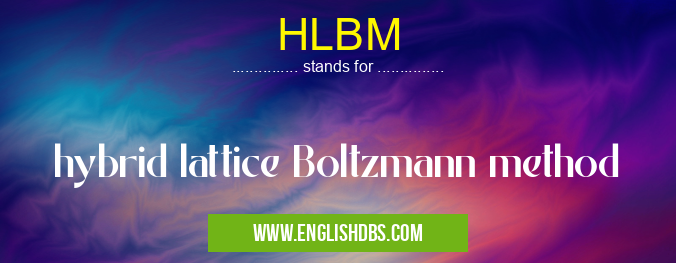What does HLBM mean in UNCLASSIFIED
The Hybrid Lattice Boltzmann Method (HLBM) is a numerical solution technique for solving partial differential equations. It combines the best features of lattice-Boltzmann methods and finite difference methods to provide a computationally efficient approach for modeling complex fluid flow systems. It has been applied to a range of problems in engineering, including fluid flows in complex geometries and transport phenomena. HLBM has been particularly successful in simulating the behavior of multiphase fluids, such as suspensions or emulsions, and the formation of droplets.

HLBM meaning in Unclassified in Miscellaneous
HLBM mostly used in an acronym Unclassified in Category Miscellaneous that means hybrid lattice Boltzmann method
Shorthand: HLBM,
Full Form: hybrid lattice Boltzmann method
For more information of "hybrid lattice Boltzmann method", see the section below.
Benefits
The main advantage of HLBM is its flexibility. By combining lattice-Boltzmann and finite difference techniques, it is possible to solve a variety of different problems with a single numerical scheme. This makes it ideal for applications that require highly accurate simulations but are limited by time or memory constraints. The accuracy of HLBM simulations can also be easily adjusted, depending on the complexity of the problem. As such, it is often used to model problems with highly nonlinear behavior, such as boundary layer flows or turbulence effects in fluids.
Applications
HLBM has been successfully applied to various types of engineering problems. It has been used to simulate heat transfer in solid materials, multiphase systems, turbulent fluids, combustion processes, waste water treatment systems, and many others. Its flexibility allows it to be used to simulate both steady-state and dynamic behavior across a range of physical properties and application conditions. Additionally, its ability to accurately predict particle dispersion characteristics make it suitable for simulating droplet formation mechanisms in wide range industrial processes.
Essential Questions and Answers on hybrid lattice Boltzmann method in "MISCELLANEOUS»UNFILED"
What is the Hybrid Lattice Boltzmann Method?
The Hybrid Lattice Boltzmann Method (HLBM) is an advanced computational technique that is used to solve complex fluid flow problems. It combines the discrete lattice approach with the traditional continuous approach, allowing for both detailed physics and efficient computation. HLBM offers a powerful set of tools with which to simulate complex multi-phase and multi-component flows.
How does HLBM work?
HLBM is based on the lattice Boltzmann equation, which defines how particles evolve through space-time on a lattice structure. By treating particles as individual entities in a finite number of states, it is possible to approximate the real continuous fluid motion with a much simpler model. Using this model, it is then possible to simulate complex physical phenomena such as shock waves and turbulence.
What are some advantages of using HLBM?
The main benefits of using HLBM include its accuracy, performance, scalability, and flexibility in terms of both model choice and simulation conditions. With HLBM it is possible to accurately capture multi-phase behavior such as turbulence or droplet coalescence with just one calculation step. Furthermore, it allows for massively parallel computing so simulations can be scaled up easily according to hardware availability. Lastly, various models, equations of state and assumptions (such as non-ideal gas flow) can be utilized in order to tailor simulations to different applications or conditions.
What kind of applications are suitable for HLBM?
HLBM has been used successfully for many engineering applications including aerospace, automotive, industrial process design/simulation and nuclear technology due to its high level of accuracy and ability to compute complex physics quickly and efficiently. Examples include air flow modeling in intakes and combustors, simulation of water flow systems or modelling detonation waves from explosives.
How does HLBM compare to other computational techniques?
While other approaches such as Finite Volume Method (FVM) or Finite Element Method (FEM) have been successfully applied for some engineering tasks in past decades; they often require more processing time than methods like the hybrid lattice Boltzmann method due to their complicated discretization techniques which lead to an increase in low frequency errors resulting from numerical diffusion. Furthermore FVM/FEM cannot easily incorporate additional physical effects into their models whereas this can be done relatively straight-forwardly in HLBM.
Are there any limitations associated with using KLBM?
One limitation associated with using KLBM is its difficulty in treating irregular geometries within a computational domain since all nodes must lie on a regular grid structure within the lattice frame work. Additionally, while KLBM has been successfully applied for laminar flows; more advanced turbulent flow simulations require larger lattices compared with traditional CFD techniques leading to longer execution times.
Is there any specific hardware requirements needed when running KLBM simulations?
The main criteria when selecting hardware specifications for running KLBM simulations include memory size and speed due to the highly intensive nature that these computations require. Furthermore GPUs are becoming increasingly popular among scientists performing HBLM calculations due their massive parallelism capabilities which allow for significant time savings.
How often do I need update my software/hardware for HBLM computations?
Software updates should be carried out regularly however actual update frequency depends on your specific research application needs as well as how quickly new software features become available form manufacturers. In terms of updating hardware; this will depend heavily on budget constraints since new technologies will always offer improved performance compared older counterparts but at increased costs.
Final Words:
The Hybrid Lattice Boltzmann Method (HLBM) offers engineers an efficient and effective way to solve partial differential equations that typically arise from the simulation of complex fluid flow systems. Its combination of lattice-Boltzmann and finite difference techniques provides an unparalleled level of accuracy whilst maintaining computational efficiency compared to other numerical solution methods. Furthermore, HLBM has proven itself useful in a variety of engineering applications involving multiphase flows and particle dispersions due to its additional capabilities not found in other numerical approaches.
